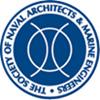Experimental and Numerical Investigation of DARPA Suboff Submarine Propelled with INSEAN E1619 Propeller for Self-Propulsion
IF 1
4区 工程技术
Q3 ENGINEERING, CIVIL
引用次数: 9
Abstract
The Defense Advanced Research Projects Agency (DARPA) Suboff Submarine propelled by the Italian Ship Model Basin (INSEAN) E1619 propeller is extensively used in submarine validation studies. Although there are several numerical studies where the DARPA Suboff submarine is used in combination with E1619 propeller there are no experimental data available in open literature for the self-propulsion condition. In this article, the self-propulsion characteristics of the DARPA Suboff submarine model with INSEAN E1619 propeller obtained with experimental and numerical methods are presented and discussed by means of Taylor wake fraction, thrust deduction, hull efficiency, relative rotative efficiency, and propulsive efficiency. To experimentally investigate the submarine form, a self-propulsion experimental setup is designed and manufactured. Resistance and self-propulsion experiments are conducted in Istanbul Technical University Ata Nutku Ship Model Testing Laboratory. Resistance tests are carried out for three different speeds, and the results show good agreement with the published experimental results. Propulsion tests are conducted by using the load-varying self-propulsion test method for constant speed and seven different propeller rotation rates. Rotational speed, thrust, and torque forces at self-propulsion point are investigated. For the numerical computations a commercial Computational Fluid Dynamics (CFD) code is used. Propeller open water characteristics and nondimensional velocities behind the propeller are calculated. Self-propulsion point of the submarine and propeller assembly is also solved numerically and the results are compared with the results obtained from the experiments, and it is seen that especially the propeller rate of revolution and thrust force are predicted with very good approximation.采用INSEAN E1619自推进螺旋桨推进DARPA水下潜艇的实验与数值研究
国防高级研究计划局(DARPA)由意大利船模盆地(INSEAN)E1619螺旋桨推进的潜艇被广泛用于潜艇验证研究。尽管有几项数值研究将DARPA Suboff潜艇与E1619螺旋桨结合使用,但公开文献中没有关于自推进条件的实验数据。本文介绍了用实验和数值方法获得的INSEAN E1619螺旋桨DARPA潜艇模型的自推进特性,并从泰勒尾流分数、推力推导、船体效率、相对旋转效率和推进效率等方面进行了讨论。为了对潜艇外形进行实验研究,设计并制造了自推进实验装置。阻力和自推进实验在伊斯坦布尔技术大学阿塔努库船舶模型测试实验室进行。在三种不同转速下进行了阻力测试,结果与已发表的实验结果吻合良好。推进试验采用恒速和七种不同螺旋桨转速的负载变化自推进试验方法进行。研究了自推进点的转速、推力和转矩。对于数值计算,使用商业计算流体动力学(CFD)代码。计算了螺旋桨开放水域的特性和螺旋桨后面的无量纲速度。对潜艇和螺旋桨总成的自推进点也进行了数值求解,并将结果与实验结果进行了比较,结果表明,特别是对螺旋桨转速和推力的预测具有很好的近似性。
本文章由计算机程序翻译,如有差异,请以英文原文为准。
求助全文
约1分钟内获得全文
求助全文
来源期刊

Journal of Ship Research
工程技术-工程:海洋
CiteScore
2.80
自引率
0.00%
发文量
12
审稿时长
6 months
期刊介绍:
Original and Timely technical papers addressing problems of shipyard techniques and production of merchant and naval ships appear in this quarterly publication. Since its inception, the Journal of Ship Production and Design (formerly the Journal of Ship Production) has been a forum for peer-reviewed, professionally edited papers from academic and industry sources. As such, it has influenced the worldwide development of ship production engineering as a fully qualified professional discipline. The expanded scope seeks papers in additional areas, specifically ship design, including design for production, plus other marine technology topics, such as ship operations, shipping economic, and safety. Each issue contains a well-rounded selection of technical papers relevant to marine professionals.
 求助内容:
求助内容: 应助结果提醒方式:
应助结果提醒方式:


